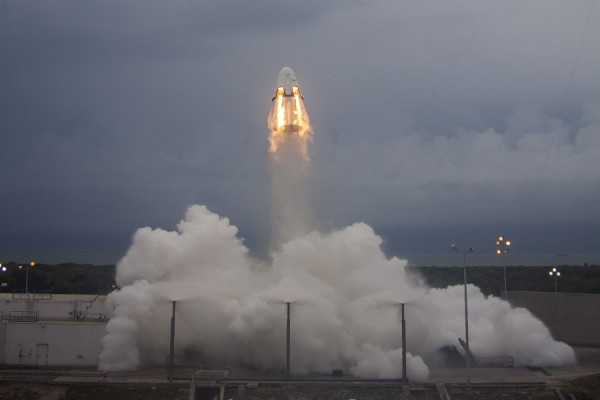SpaceX Crew Dragon's First Pad Abort Test Successful
| Ana Verayo | | May 10, 2015 05:17 AM EDT |
(Photo : SpaceX) Dragon traveled from 0-100 mph in 1.2 seconds, reaching a max velocity of 345 mph.
Last Wednesday, SpaceX has demonstrated the abort system capabilities of the Crew Dragon spacecraft that is specifically designed for astronauts to escape the vehicle in the event of life threatening circumstances occurring on the launch pad.
Like Us on Facebook
The Crew Dragon spacecraft was launched into space with the help of eight powerful SuperDraco engines from the Complex 40 at Cape Canaveral Air Force Station in Florida. As the engines were fired, each one of them delivered a 15,000 pound thrust that lifted the spacecraft high over the Atlantic ocean.
Then the Crew Dragon dropped its trunk that was parachuted into safety as planned. The whole test from engine ignition to splashdown just lasted about two minutes.
Kathy Lueders who is the Commercial Crew Program manager for NASA, had given her congratulations to the success of the test flight and applauding SpaceX's efforts for its Crew Dragon and for their achievement of certification from NASA.
This particular flight test is also a pivotal milestone for SpaceX since the private space company is involved in a billion dollar contract with NASA to develop and build a spacecraft that will ferry humans to Mars.
In order to do so, SpaceX will use this data gathered from the test flight to improve aerodynamic models of the craft and develop a design that can also guarantee the safety of the crew from launch to spaceflight to touchdown on an alien world.
According to Space X president and chief operating officer Gwynne Shotwell, the company has set its foundations on sending people to space and other alien worlds. This NASA partnership is a crucial development for the Crew Dragon where this successful test flight can guide SpaceX in keeping track of its future manned spaceflight missions already slated for 2017.
Apart from its engine boosters, some 270 special scientific instruments such as accelerometers and temperature sensors were aboard the Crew Dragon in order to measure and record data like acceleration and stresses on the vehicle.
A dummy was also strapped into the test flight vehicle in order to demonstrate how the escape system affects the human body. Weights were also included that are also strapped onto the crew seats to simulate the amount of mass on a mission launch.
Apart from SpaceX's efforts to develop and test a spacecraft for future manned missions, NASA is also preparing the International Space Station for commercial spacecrafts such as the CST-100 from Boeing for docking. NASA's plan is to ferry four astronauts to the ISS during every mission until the crew forms seven members to conduct more scientific experiment aboard the orbiting space lab.
TagsSpaceX, Crew Dragon, SpaceX Crew Dragon abort test, SpaceX Crew Dragon pad abort test, NASA
©2015 Chinatopix All rights reserved. Do not reproduce without permission
EDITOR'S PICKS
-

Did the Trump administration just announce plans for a trade war with ‘hostile’ China and Russia?
-

US Senate passes Taiwan travel bill slammed by China
-

As Yan Sihong’s family grieves, here are other Chinese students who went missing abroad. Some have never been found
-

Beijing blasts Western critics who ‘smear China’ with the term sharp power
-

China Envoy Seeks to Defuse Tensions With U.S. as a Trade War Brews
-

Singapore's Deputy PM Provides Bitcoin Vote of Confidence Amid China's Blanket Bans
-

China warns investors over risks in overseas virtual currency trading
-

Chinese government most trustworthy: survey
-

Kashima Antlers On Course For Back-To-Back Titles
MOST POPULAR
LATEST NEWS
Zhou Yongkang: China's Former Security Chief Sentenced to Life in Prison

China's former Chief of the Ministry of Public Security, Zhou Yongkang, has been given a life sentence after he was found guilty of abusing his office, bribery and deliberately ... Full Article
TRENDING STORY

China Pork Prices Expected to Stabilize As The Supplies Recover

Elephone P9000 Smartphone is now on Sale on Amazon India

There's a Big Chance Cliffhangers Won't Still Be Resolved When Grey's Anatomy Season 13 Returns

Supreme Court Ruled on Samsung vs Apple Dispute for Patent Infringement

Microsoft Surface Pro 5 Rumors and Release Date: What is the Latest?










